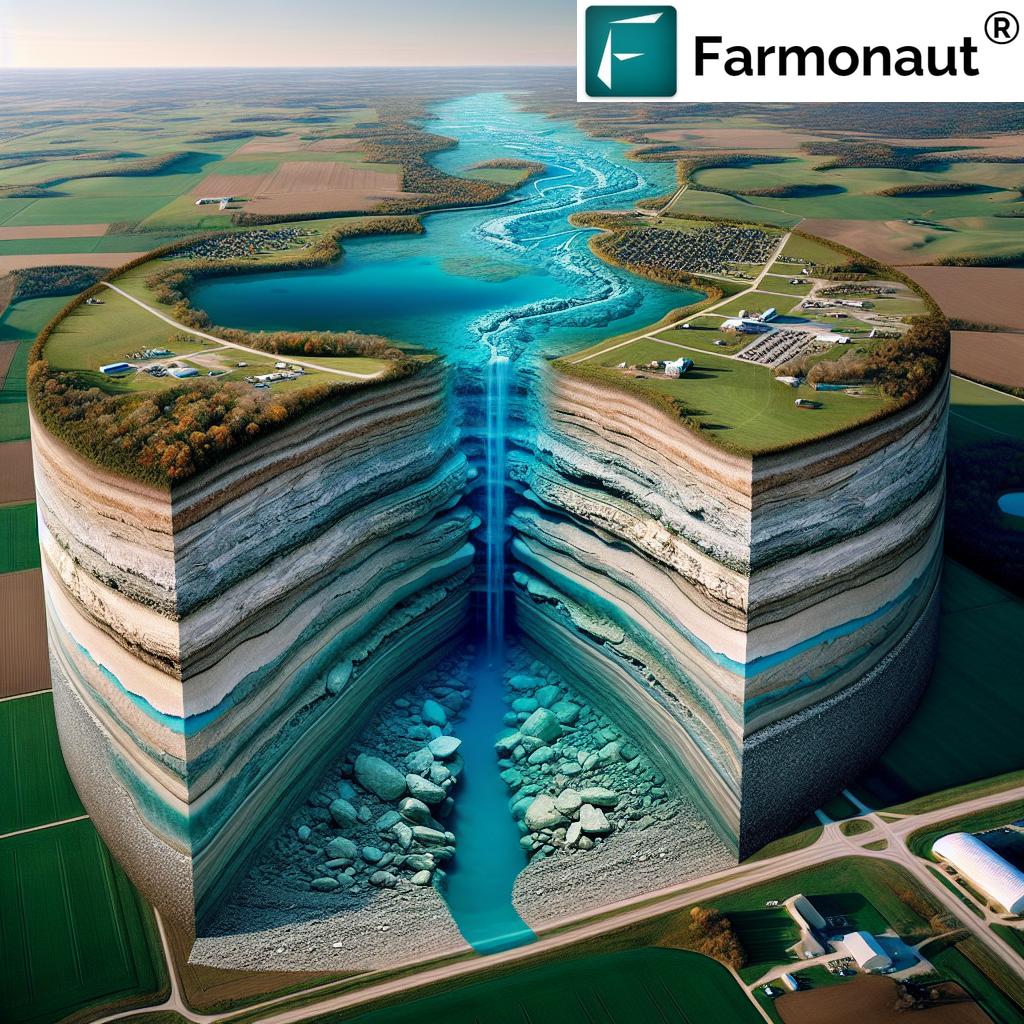Illinois Carbon Sequestration Ban: Protecting the Mahomet Aquifer’s Drinking Water Safety
“The Mahomet Aquifer supplies drinking water to over 500,000 people in Central Illinois.”
In recent developments, Illinois lawmakers have taken a significant step towards safeguarding one of the state’s most crucial water resources. The Illinois Senate has unanimously passed a bill that aims to ban carbon sequestration activities over the Mahomet Aquifer, a vital source of drinking water for Central Illinois. This legislative action highlights the complex interplay between environmental policy, groundwater protection measures, and emerging carbon storage regulations in the state.
As we delve into this critical issue, it’s important to understand the various aspects at play, from the geological significance of the Mahomet Aquifer to the potential risks and benefits of carbon sequestration technology. In this comprehensive analysis, we’ll explore the implications of this ban, the science behind carbon storage, and the broader context of environmental protection in Illinois.
Understanding the Mahomet Aquifer
The Mahomet Aquifer is a vast underground layer of water-bearing sand and gravel that stretches across 15 counties in Central Illinois. This natural reservoir is the primary source of drinking water for over half a million residents, including those in Normal, Champaign, and Urbana. The aquifer’s importance cannot be overstated – it’s a lifeline for communities that have no alternative water source of comparable scale and quality.
Key facts about the Mahomet Aquifer:
- Underlies 15 counties in Central Illinois
- Supplies drinking water to more than 500,000 people
- Composed of deep underground layers of sand and gravel
- Designated as a “sole source aquifer” by the U.S. Environmental Protection Agency (EPA)
Given its critical role in supplying clean, safe drinking water to such a large population, protecting the Mahomet Aquifer from potential contamination is a top priority for local communities and state lawmakers alike.
The Carbon Sequestration Debate
Carbon sequestration, also known as carbon capture and storage (CCS), is a technology designed to reduce carbon dioxide emissions by capturing CO2 from industrial processes and injecting it deep underground for long-term storage. While this technology has been touted as a potential solution to mitigate climate change, it also raises concerns about its impact on groundwater resources.
Illinois, particularly the downstate region, has been identified as an attractive location for carbon sequestration projects due to its favorable geology. However, the proximity of potential storage sites to the Mahomet Aquifer has sparked a heated debate about the safety and wisdom of such projects.
The Legislative Response
In response to these concerns, Illinois lawmakers have taken decisive action. Senate Bill 1723, which passed unanimously in the Illinois Senate, seeks to ban carbon sequestration activity within an area that “overlies, underlies, or passes through” the Mahomet Aquifer. This legislation represents a cautious approach to balancing environmental protection with emerging technologies.
State Senator Paul Faraci, the bill’s sponsor, emphasized the importance of this measure: “Our communities rely on the Mahomet Aquifer for safe, clean drinking water. There is no backup plan. While carbon sequestration has potential, we cannot gamble with the health of almost one million people. This bill ensures we don’t put short-term projects ahead of long-term water security.”
Recent Amendments and Controversies
It’s worth noting that recent amendments to the bill have sparked some controversy. The protected area boundaries have been adjusted to apply only to the area designated by the U.S. EPA as the “sole source aquifer area,” rather than the slightly larger “project review area” initially proposed. This change excludes some regions, including Bloomington-Normal and parts of McLean and Ford counties, from the protected zone.
This modification has led to debate among environmental advocates, with some expressing concern that it could weaken the bill’s effectiveness. However, supporters of the amendment argue that it allows for a more targeted approach based on current scientific understanding of the aquifer’s boundaries.
The Science Behind Carbon Sequestration and Aquifer Protection
To fully grasp the implications of the carbon sequestration ban, it’s crucial to understand the scientific principles at play. Carbon sequestration involves capturing CO2 emissions from industrial sources and injecting them into deep geological formations for long-term storage. In theory, this process can help reduce greenhouse gas emissions and mitigate climate change.
However, when it comes to protecting vital water resources like the Mahomet Aquifer, several key considerations come into play:
- Geological stability: The integrity of the rock formations above and around the injection site is critical to prevent CO2 leakage.
- Pressure changes: Injecting CO2 can alter subsurface pressures, potentially affecting groundwater flow patterns.
- Chemical interactions: CO2 can interact with subsurface minerals and fluids, potentially altering water chemistry.
- Long-term monitoring: Ensuring the safety of sequestered CO2 requires ongoing monitoring and verification.
While studies have indicated that there is minimal risk to drinking water from properly managed sequestration activity, the lack of a clear alternative water source if anything were to go awry has led to a zero-risk tolerance approach in Central Illinois.
Comparative Analysis: Carbon Sequestration Impact on the Mahomet Aquifer
| Aspect | Without Carbon Sequestration (Current State) | Potential Impact with Carbon Sequestration | Risk Level | Mitigation Measures |
|---|---|---|---|---|
| Water Quality | Stable, meets drinking water standards | Potential for pH changes, mineral dissolution | Medium | Advanced monitoring systems, protective well designs |
| Geological Stability | Natural equilibrium | Possible pressure changes, minor seismicity | Low | Careful site selection, pressure management |
| Environmental Impact | Minimal anthropogenic influence | Reduced atmospheric CO2, potential local ecosystem changes | Low to Medium | Comprehensive environmental impact assessments |
| Long-term Sustainability | Stable water source for centuries | Uncertainty about very long-term effects (1000+ years) | High | Ongoing research, adaptive management strategies |
This comparative analysis underscores the complexity of the issue and the need for a cautious, science-based approach to protect this vital water resource.
The Role of Environmental Policy and Regulations
The debate surrounding carbon sequestration and aquifer protection in Illinois is part of a broader conversation about environmental policy and regulations. As we navigate the challenges of climate change and resource management, policymakers must balance various interests and priorities.
“Illinois Senate unanimously passed a bill banning carbon sequestration over the Mahomet Aquifer to protect water safety.”
In Illinois, recent legislative actions have aimed to create a comprehensive framework for carbon capture and sequestration activities. Last year, lawmakers passed and Governor Pritzker signed legislation that built upon existing federal regulations, adding key protections such as:
- A two-year moratorium on pipeline construction
- Additional permitting requirements
- Enhanced safety provisions
However, the exclusion of a specific ban on carbon injections underneath sole source aquifers led to the current push for additional protections for the Mahomet Aquifer.
Local Government Response
The concern over protecting the Mahomet Aquifer has not been limited to state-level action. Several local governments, including the McLean and Ford county boards, have passed resolutions supporting legislation to protect the aquifer. This grassroots support underscores the importance of the issue to local communities and their desire for strong protective measures.
Case Study: ADM’s Carbon Sequestration Project
The need for stringent regulations and careful oversight of carbon sequestration projects was highlighted by recent events involving Archer Daniels Midland Co. (ADM). The company was cited by the U.S. EPA for injection activity not allowed under its federal carbon sequestration permit and for violating the Safe Drinking Water Act.
ADM has been injecting carbon dioxide underneath its Decatur facility, just outside the Mahomet Aquifer footprint, for over a decade. However, company officials discovered that injected carbon had seeped from a corroded monitoring well pipe into the ground about 5,000 feet below the surface. While this was well below any drinking water sources, it was 500 feet above where ADM is permitted to inject carbon.
This incident, although not directly affecting the Mahomet Aquifer, has raised concerns about the potential risks associated with carbon sequestration activities and the need for rigorous monitoring and enforcement of regulations.
The Future of Carbon Sequestration in Illinois
As of now, there are 23 carbon injection permit applications pending before the U.S. EPA in Illinois, including some within the Mahomet Aquifer’s footprint. The passage of Senate Bill 1723, if signed into law, would significantly impact these projects and shape the future of carbon sequestration in the state.
The legislation also calls for a comprehensive scientific study to assess the safety and risks of carbon storage within the aquifer region. This study, to be conducted by the Prairie Research Institute at the University of Illinois at Urbana-Champaign, will play a crucial role in informing future policy decisions.
The Study Commission
A key component of the legislation is the creation of a new 17-member study commission. This body will include representatives from various state agencies and appointees of the four state legislative leaders. The commission’s mandate is to review the scientific findings and make recommendations regarding carbon sequestration activities in relation to the Mahomet Aquifer.
The formation of this commission raises questions about the effectiveness of existing bodies, such as the Mahomet Aquifer Council, which was formed in 2021 but has never met due to a lack of quorum. Senator Faraci expressed optimism about the new commission’s potential for success, citing its more targeted mission and the urgency of the issue.
Balancing Environmental Protection and Technological Innovation
The debate over carbon sequestration in Illinois exemplifies the broader challenges of balancing environmental protection with technological innovation in addressing climate change. While carbon capture and storage technology offers potential benefits in reducing greenhouse gas emissions, the protection of vital resources like the Mahomet Aquifer must remain a top priority.
As we consider the future of carbon sequestration in Illinois and beyond, several key factors must be taken into account:
- The need for robust scientific research and monitoring
- The importance of transparent decision-making processes
- The value of public engagement and education on complex environmental issues
- The potential for technological advancements to mitigate risks
- The long-term implications of carbon storage for future generations
Conclusion: A Path Forward
The unanimous passage of Senate Bill 1723 in the Illinois Senate marks a significant step in the ongoing effort to protect the Mahomet Aquifer and ensure the safety of drinking water for hundreds of thousands of Illinois residents. As the bill moves to the House for consideration, it will undoubtedly continue to spark debate and discussion about the future of carbon sequestration in the state.
Ultimately, the path forward will require a delicate balance between environmental protection, technological innovation, and economic considerations. By prioritizing scientific research, fostering open dialogue, and maintaining a commitment to the health and safety of Illinois residents, policymakers can work towards solutions that address both immediate concerns and long-term sustainability goals.
As we continue to grapple with the complex challenges of climate change and resource management, the debate surrounding carbon sequestration and aquifer protection in Illinois serves as a crucial case study in environmental policymaking. It underscores the importance of local action, scientific expertise, and careful consideration of long-term consequences in shaping our approach to emerging technologies and environmental challenges.
FAQs
- What is carbon sequestration?
Carbon sequestration is the process of capturing and storing atmospheric carbon dioxide to mitigate climate change. In the context of this article, it refers specifically to the injection of CO2 into deep underground geological formations for long-term storage. - Why is the Mahomet Aquifer so important?
The Mahomet Aquifer is a crucial source of drinking water for over 500,000 people in Central Illinois. It’s designated as a “sole source aquifer,” meaning there are no viable alternative drinking water sources that could easily replace it if contaminated. - What are the potential risks of carbon sequestration to the aquifer?
While studies suggest minimal risk when properly managed, concerns include potential leakage of CO2, changes in groundwater chemistry, and alterations to subsurface pressure that could affect water flow patterns. - What does Senate Bill 1723 propose?
The bill aims to ban carbon sequestration activities within an area that overlies, underlies, or passes through the Mahomet Aquifer, as defined by the U.S. EPA’s “sole source aquifer area” designation. - How will the proposed scientific study impact future decisions?
The study, to be conducted by the Prairie Research Institute, will assess the safety and risks of carbon storage within the aquifer region. Its findings will inform future policy decisions and potentially lead to adjustments in the protected area boundaries.
As we conclude this exploration of the Illinois carbon sequestration ban and its implications for the Mahomet Aquifer, it’s clear that the intersection of environmental protection, technological innovation, and public health will continue to be a critical area of focus for policymakers and communities alike. By staying informed and engaged in these important discussions, we can all play a role in shaping a sustainable and secure future for our water resources and our environment.
While discussing environmental protection and sustainable practices, it’s worth noting the role of technology in modern agriculture. Farmonaut’s carbon footprinting solution offers farmers and agribusinesses a way to monitor and reduce their environmental impact. This tool provides real-time data on emissions, allowing for more sustainable farming practices that align with environmental regulations.
For those interested in precision agriculture and sustainable farming practices, Farmonaut’s satellite-based farm management solutions offer valuable insights for crop health monitoring and resource optimization. These tools can help farmers make informed decisions that not only improve productivity but also contribute to environmental conservation efforts.
Earn With Farmonaut: Affiliate Program
Earn 20% recurring commission with Farmonaut’s affiliate program by sharing your promo code and helping farmers save 10%. Onboard 10 Elite farmers monthly to earn a minimum of $148,000 annually—start now and grow your income!
As we continue to address environmental challenges and seek sustainable solutions in agriculture and beyond, innovative technologies and data-driven approaches will play an increasingly important role. By leveraging these tools and staying informed about crucial environmental issues like the protection of vital water resources, we can work towards a more sustainable and resilient future for all.

















